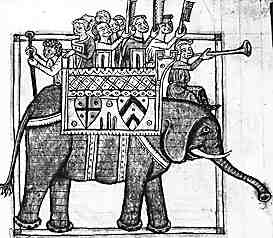


If you are looking at this page without frames, there is more information about medieval writing to be found by going to the home page (framed) or the site map (no frames).
| Bestiaries (3) | |||
 |
Depiction of an elephant in a 13th century bestiary (British Library, Harley 3244, f.39). By permission of the British Library. | ||
| Exotic animals like elephants were often depicted very inaccurately in the bestiaries. Elephants might be given hooves, peculiar tails or strange multi-lobed ears. The visual depiction was as faulty as the description of the animal's habits, and was obtained from the literary tradition rather than life. | |||
| Sometimes, as in the above illustration, it appears that the artist had actually seen an elephant. The traditional fighting castle on this elephant has been replaced with a carrier for a bunch of crazy looking people who are apparently in party mode. King Henry III of England was actually given an elephant by King Louis IX of France. It didn't live very long, but it was paraded around the streets of London. This must have seemed like the bestiary coming to life, and one can imagine its presence strengthening belief in many of the other peculiar creatures from the literary tradition. | |||
| This particular elephant visited Canberra in January 2002 for an exhibition at the National Library of Australia. I would like to thank the British Library for allowing me to meet my favourite elephant in the flesh. | |||
| Various kinds of highly decorated works like psalters were decorated with animal ornament in the margins. Sometimes these were purely fantastical, even ludicrous. Sometimes they represented the imagery from the bestiary stories. | |||
 |
Image from the margin of an early 14th century psalter, known as Queen Mary's Psalter (British Library, Royal 2 B VII, f.111). By permission of the British Library. | ||
| The image above represents the bestiary story of the apsidochelone, or whale. The hapless sailors are busily boiling their cooking pot on the creature's disguised back. It is assumed that the reader will know what happens next. The creature dives, drowning the sailors. The image is part of a familiar folklore, albeit derived from literate sources. | |||
 |
Another image from the same source (British Library, Royal 2 B VII, f. 129). By permission of the British Library. | ||
| This marginal illustration shows birds chasing away an owl. It looks innocently bucolic, but it also refers to a bestiary description. The owl was taken to represent the Jews, blind in the light of day or knowledge. The persecution of the owls by other birds was taken to legitimise medieval Christian attitudes to the Jews. So a pretty little picture of birds and trees is transformed via an allegorical reading in a Christian text to a justification for intolerance and prejudice against fellow humans. It is illustrating a passage from the Psalms, a Jewish text in origin, of course. | |||
| It is possible to expend a lot of time and energy tracing the stories and imagery of the bestiaries from life into literature and back again, from one form of metaphor to another, from folklore to reality and back. There is much more to them than just a bunch of jumbled up animal stories. | |||
|
|
|||
|
|
|||
|
If you are looking at this page without frames, there is more information about medieval writing to be found by going to the home page (framed) or the site map (no frames). |
|||